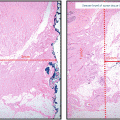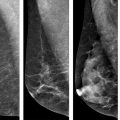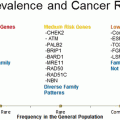Study
Initial biopsy period
# cases
F/U (years)
# subsequent invasive cancers (%)
Betsill et al. [11]
1940–1950
10
21.6
6 (60 %)
Rosen et al. [10]
(expansion of Betsill study)
1940–1950
15
18
10 (66 %)
Page et al. [12]
1950–1968
25
15
7 (28 %)
Page et al. [13]
(expansion of Page study)
1950–1968
28
30
9 (32 %)
Sanders et al. [14]
(follow-up and expansion of Page study)
1950–1968
28
46
11 (39 %)
Identifying which cases of DCIS can be safely managed with a minimized-treatment approach has been the challenge addressed by several prospective, randomized clinical trials that have been reviewed in this chapter. This chapter focuses on reviewing the major cooperative group-designed studies that have been conducted internationally in evaluating surgery and adjuvant therapy for DCIS. Since the preinvasive nature of DCIS defines its primary management requirements as focusing on local therapy to the breast alone, most studies have involved comparisons of lumpectomy with versus without radiation therapy. Other studies have looked at the value of endocrine therapy as well, because of the antiproliferative effects of these treatments and also because of the fact that approximately three quarters of DCIS lesions are hormone receptor positive [15]. Furthermore, it has been consistently demonstrated that half of the local recurrences following breast-conserving treatment of DCIS are detected as invasive cancers, and studies of endocrine therapy have also sought to determine whether these systemic agents might also have an impact on either survival or risk of invasive recurrence. This chapter also reviews the limited information available on primary prevention of DCIS from the perspectives of the international chemoprevention studies as well as from data on incidence of contralateral breast cancer in women receiving adjuvant endocrine therapy for hormone receptor-positive invasive breast cancers . Of note, most data on endocrine agents for either prevention or treatment of DCIS have focused on selective estrogen receptor modulation. An additional goal of this chapter is to review the growing body of literature on aromatase inhibition and DCIS, since some of these data are available from chemoprevention studies as well as adjuvant therapy trials. Finally, we review trends in treatment for DCIS as reflected by the surveillance, epidemiology, and end results (SEER) program.
Clinical Trials of DCIS Treatment
In the premammography era, cases of DCIS and invasive breast cancer were largely detected as similar patterns by clinical presentation as palpable lumps or bloody nipple discharge . They were also, therefore, treated with comparable surgical approaches, including mastectomy prior to the clinical trials of breast-conservation surgery. The national surgical adjuvant breast project (NSABP) B-06 trial was the major trial designed to compare mastectomy with breast-conserving surgery and conducted in the USA. This trial randomized more than 1800 women with operable breast cancers measuring up to 4 cm in size to one of three different treatment arms: lumpectomy alone, lumpectomy plus whole breast radiation, and mastectomy. All patients underwent a staging axillary lymph node dissection as well, as this pathologic regional nodal information was necessary for determining adjuvant systemic therapy needs and lymphatic mapping/sentinel lymph node biopsy had not yet become available as an axillary staging procedure during the 1970s–1980s when this trial was accruing and monitoring participants. A 20-year follow-up of these patients has confirmed the overall survival equivalence for all three treatment arms [16]. Although the B-06 study was designed to study breast conservation among women with invasive breast cancer , it remains the only prospective, randomized clinical trial providing head-to-head comparisons of mastectomy versus breast conservation in cases of DCIS . Centralized pathology review subsequently revealed that 78 trial participants actually had DCIS rather than invasive disease, and the outcomes for these patients (who were evenly balanced between the three randomization arms) have been reported [17] . These data are shown in Table 6.2 [17]. Overall survival was equal at 96 % and 83 months follow-up. Local recurrences were reduced from 42.8 to 7.4 % among the lumpectomy patients receiving radiation therapy, and there were no local recurrences among the mastectomy cases. As shown by many other studies of breast conservation for DCIS, approximately half of all recurrences were invasive, demonstrating the importance of local control as a factor in minimizing the likelihood of the patient ever having to face the more extensive surgical and systemic therapy treatment needs of invasive breast cancer .
Table 6.2
Subset analysis of National Surgical Adjuvant Breast Project (NSABP) trial B-06, demonstrating outcomes for patients with ductal carcinoma in situ (DCIS) that were inadvertantly randomized in this trial that was designed to evaluate the safety of breast-conserving surgery compared with mastectomy in patients with invasive breast cancers up to 4 cm in size. This subset analysis represents the only direct comparison of mastectomy versus lumpectomy in cases of DCIS within the context of a prospective, randomized clinical trial [17]
Study | NSABP B-06 [17] | ||
|---|---|---|---|
Study goal and eligibility requirements | Designed to evaluate the safety of breast conservation invasive breast cancers; primary tumor up to 4 cm | ||
Inked lumpectomy margin tumor-free | |||
Average follow-up | 83 months | ||
Randomization armsa | Lumpectomy alone | Lumpectomy + whole-breast radiation | Mastectomy |
No. of patients | 21 | 27 | 28 |
No. of local recurrences (%) | 9 (42.8 %) | 2 (7.4 %) | 0 (0 %) |
No. of invasive local recurrences (%) | 5/9 (45 %) | 1/2 (50 %) | NA |
Overall survival (all causes) | 96 % | 96 % | 96 % |
Risk factors for local recurrence | Lack of XRT following lumpectomy Comedonecrosis | ||
Other prospective, randomized clinical trials have since specifically addressed breast-conserving surgery in DCIS patients, but with adjuvant radiation and/or tamoxifen serving as the comparison arms. Results from these trials are summarized in Table 6.3 [3, 18–25].
Study | NSABP B-24 [24] | UK/AZ [25] | ||||||||
|---|---|---|---|---|---|---|---|---|---|---|
Trial goals and eligibility requirements | Designed to evaluate lumpectomy with versus without breast XRT | Designed to evaluate lumpectomy with versus without breast XRT | Designed to evaluate the added benefit of tamoxifen as adjuvant therapy for DCIS patients treated with lumpectomy and breast XRT | Designed to assess the effectiveness of adjuvant tamoxifen and/or XRT after lumpectomy | ||||||
Mammographically detected DCIS ≤ 5 cm | DCIS detected by mammogram or physical exam | DCIS detected by mammogram or physical exam | DCIS respectable by lumpectomy | |||||||
No margin specification | Inked margin tumor-free | Inked margin tumor-free | Inked margin tumor-free | |||||||
Accrual years | 1986–1996 | 1985–1990 | 1991–1994 | 1990–1998 | ||||||
Average follow-up (months) | 126 | 90 | 74 | 53 | ||||||
Randomization arms | Lump | Lump + XRT | Lump | Lump + XRT | Lump + XRT | Lump + XRT + Tam | Lump | Lump + Tam | Lump + XRT | Lump + Tam + XRT |
# Patients | 503 | 507 | 403 | 411 | 902 | 902 | 544 | 567 | 267 | 316 |
# Local recurrences (%) | 132 (26.2 %) | 75 (14.8 %) | 104 (25.8 %) | 47 (11.4 %) | 87 (9.6 %) | 63 (7.0 %) | 119 (22 %) | 101 (18 %) | 22 (8 %) | 21 (6 %) |
# Invasive local recurrences (%) | 66/132 (50 %) | 40/75 (53 %) | 53/104 (51 %) | 17/47 (36 %) | 40/87 (46 %) | 23/63 (37 %) | 39/119 (33 %) | 43/101 (43 %) | 12/22 (55 %) | 14/21 (67 %) |
Overall survival (all causes) | 95 % | 95 % | 97 % | 96 % | 97 % | 97 % | NR | NR | NR | NR |
Risk factors for local recurrence | Lack of XRT Age £ 40 years Symptomatic DCIS Involved margins Non-well-differentiated DCIS Solid/cribriform/comedo patterns | Lack of XRT Calcifications on mammogram | Lack of tamoxifen Age 50 years Involved margins Comedonecrosis Symptomatic DCIS | Lack of XRT | ||||||
The NSABP B-17 trial was specifically designed to evaluate breast conservation in women with DCIS, but mastectomy was not one of the randomization arms. Having accepted the safety of breast-conservation therapy in terms of overall survival for DCIS patients based upon retrospective data, the B-17 trial was initiated in 1985 and sought to evaluate the value of lumpectomy with versus without adjuvant, 50-Gy whole-breast radiation [22, 23, 26, 27] . Overall survival at 8 years was similarly high for the 818 patients randomized to lumpectomy alone versus lumpectomy/radiation (94 % vs. 95 %, respectively; relative risk 1.07; 95 %, confidence interval 0.82–1.39; p = 0.084) [22] . Adjuvant radiation therapy reduced the incidence of noninvasive breast local recurrences from 13.4 to 8.2 % (p = 0.007) and reduced the incidence of invasive recurrences from 13.4 to 3.9 % (p < 0.0001) . At 12 years follow-up ipsilateral breast tumor recurrence was reduced by 57 % in the radiation arm (rate ratio 0.43) [28]. Pathologic findings suggested that the extent of comedo necrosis was associated with risk of local recurrence (and therefore predicted for benefit from radiation therapy) [23]. A tumor-free inked margin surface was mandated by central pathology review also evaluated outcomes according to the extent and/or uncertainty of margin control. Interestingly, while margin negativity correlated with local recurrence in the 5-year follow-up analysis, it was no longer significant at 8 years; the investigators, nonetheless, remained advocates of margin-free resections for DCIS lumpectomies [23]. Approximately 80 % of cases were associated with microcalcifications [22]; however, no specific data are available on post-lumpectomy mammography findings (which can be a confounding factor related to margin status, and therefore can potentially impact local recurrence risk) .
The European Organization for Research and Treatment of Cancer (EORTC) Randomized Phase III Trial 10853 involved 1010 women with DCIS [19–21], and these patients received either lumpectomy alone or lumpectomy followed by 50-Gy whole-breast radiation. Margin status was defined as negative if reported as having at least a 1-mm margin or through the performance of a reexcision lumpectomy. As with the NSABP B-17 trial, post-lumpectomy imaging was not mandated and so local recurrence cannot be assessed on the basis of margin control in conjunction with confirmed adequacy of resecting mammographic microcalcifications . Ten-year overall survival rates were 95 % for both randomization arms; but at median 10.5 years follow-up, radiation therapy was associated with a significant reduction in 10-year local recurrence-free survival (85 % vs. 74 %; p < 0.0001; hazard ratio = 0.053) [20]. Multivariate analysis revealed that young age (≤ 40 years); intermediate or poorly differentiated histology; cribriform or solid growth pattern; and questionable margins were all associated with an increased risk for local recurrence [20] .
Stay updated, free articles. Join our Telegram channel

Full access? Get Clinical Tree







